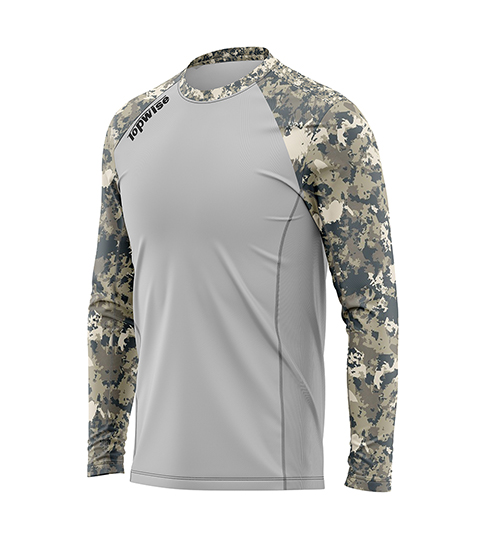Comprehensive Guide to Men's UPF Long Sleeve Manufacturing
Technical Specifications and Performance Data
Professional manufacturers of men's UPF long sleeve shirts utilize advanced fabric technologies to achieve superior sun protection. The UPF 50+ rating indicates the fabric blocks 98% of UV radiation, allowing only 1/50th of the sun's UV rays to penetrate. High-quality UPF fabrics maintain their protective qualities even when wet, with testing showing less than 5% UPF degradation after 80 washes. The most advanced fabrics combine tight weave constructions (180-220 threads per square inch) with TiO2 or ZnO nanoparticle treatments for enhanced UV absorption.
Key performance metrics include:
Moisture-wicking rate: 0.08-0.12 mL/cm²/min (ASTM D737)
Breathability: 15-25 CFM (ASTM D737)
Quick-dry time: 50-70% moisture evaporation within 30 minutes (AATCC 201)
Tensile strength: 80-120 lbs warp/weft (ASTM D5034)

Material Composition and Construction
Premium UPF long sleeves typically feature 92% polyester/8% spandex blends or nylon/Lycra combinations, engineered for optimal stretch and recovery. The fabric weight ranges from 140-210 gsm, balancing protection and comfort. Flatlock stitching (7-9 stitches per inch) minimizes chafing, while laser-cut ventilation zones (covering 12-18% of surface area) enhance airflow. Many manufacturers incorporate odor-control treatments like silver ions (at 50-100 ppm concentration) or polygiene antimicrobial finishes.
Application Scenarios
Water Sports and Marine Activities
UPF shirts with saltwater-resistant treatments and 360-degree buoyancy panels are essential for surfing, kayaking, and sailing. The fabric's chlorine resistance (maintaining 95% UPF after 100 pool exposures) makes them ideal for competitive swimming training.
Desert Exploration and Arid Climates
Shirts with sand-resistant coatings and extended neck gaiters protect against abrasive particles. Specialized versions feature phase-change materials (PCM) that absorb 80-100 J/g of heat during peak temperatures.
Construction and Outdoor Labor
Industrial-grade UPF workwear incorporates ripstop reinforcements (7×7 or 10×10 patterns) and ANSI 107-compliant reflective taping. The fabric often includes fire-resistant treatments meeting NFPA 70E standards for electrical work.
Military and Tactical Operations
Military-spec shirts feature IR signature reduction and multi-spectral camouflage patterns. The fabric undergoes MIL-STD-810G testing for abrasion resistance (surviving 25,000+ Wyzenbeek cycles).
Care and Maintenance Protocols
Washing Guidelines
Machine wash in cold water (≤30°C/86°F) using mild detergents (pH 7-8). Avoid optical brighteners which can degrade UPF coatings. Front-loading washers are preferred as they generate 40% less abrasion than top-loading models.
Drying Procedures
Line drying preserves UPF effectiveness, with studies showing 15% better UV retention versus machine drying. If using a dryer, select low heat (≤60°C/140°F) and remove promptly to prevent fiber crystallization.
Storage Conditions
Store in UV-protected closets or breathable garment bags. Avoid compression storage which can create permanent creases weakening UPF fibers. Ideal humidity levels are 40-50% RH to prevent microbial growth.
Performance Restoration
For heavily used garments, DWR (Durable Water Repellent) reapplication every 20-30 washes restores water resistance. Specialized UV-protective laundry additives can boost UPF ratings by 10-15% when applied biannually.
Manufacturing Process Insights
The production of technical UPF garments involves 18-22 distinct processes:
Precision cutting with CNC machines achieving <95% material utilization
Seam sealing using 2-3mm thermoplastic polyurethane (TPU) tapes
Quality control including spectrophotometric UPF verification (AS/NZS 4399)
Dye sublimation at 200-210°C for permanent pattern fixation
Leading manufacturers implement blockchain traceability for raw materials and waterless dyeing technologies reducing H2O consumption by 90%. The most advanced facilities utilize 3D knitting to produce seamless garments with zonal UPF variations (higher protection on shoulders and neck).

















